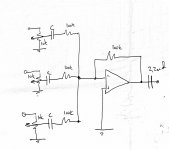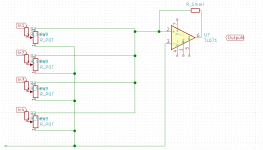Good day.
I want to build the attached circuit. I want to minimize component count a little as this is part of a bigger project.
Are the input capacitors really necessary?
These inputs will only be connected to other audio sources such as an ipad or mixer.
Thank you in advance.
I want to build the attached circuit. I want to minimize component count a little as this is part of a bigger project.
Are the input capacitors really necessary?
These inputs will only be connected to other audio sources such as an ipad or mixer.
Thank you in advance.
Attachments
If you need the capacitors, place them before your pots.
I agree 10k would be a better choice but as you turn the pot down, the gain will increase, so wire the top of the pots together with the 10k resistors between each one and feed the pots on the wipers using a 47k and your capacitor to the wipers.
Wipers = input and the top of the pots go to the IC.
I agree 10k would be a better choice but as you turn the pot down, the gain will increase, so wire the top of the pots together with the 10k resistors between each one and feed the pots on the wipers using a 47k and your capacitor to the wipers.
Wipers = input and the top of the pots go to the IC.
Attachments
Last edited:
You're gonna be looking at a noisy circuit with those 100KΩ resistors. 10KΩ will be better. The caps are there to block DC from your sources. Are you absolutely sure that they have ZERO DC on them?
Unfortunately the 100k resistors are mandated with 10k pots to avoid loading them too much. This is more a passive mixer circuit, with a buffer on the end, there are better, fully active, mixer circuits using a current summing junction and buffers on each channel (increasing the component count though). These better circuits can be designed for low noise. Usually lower noise means more opamps, because you need to keep impedances down.
I want to minimize component count a little as this is part of a bigger project. These inputs will only be connected to other audio sources such as an ipad or mixer.
So, use 2KΩ pots with 20KΩ resistors. Any decent opamp will drive a 2KΩ load.Unfortunately the 100k resistors are mandated with 10k pots to avoid loading them too much.........you need to keep impedances down.
Unfortunately the 100k resistors are mandated with 10k pots to avoid loading them too much. This is more a passive mixer circuit, with a buffer on the end, there are better, fully active, mixer circuits using a current summing junction and buffers on each channel (increasing the component count though). These better circuits can be designed for low noise. Usually lower noise means more opamps, because you need to keep impedances down.
You can use linear 100K pots loaded by 10K resistors, which would give you a taper similar to audio taper (and often better tracking). Better would be 47K pots/10K resistors, or 100K pots/14.7K resistors, or 10K pots/2.2K or 1.47K resistors.
You can reduce noise by using low noise, high resonance wirewound resistors like Vishay Dale CMF "Industrial Series" resistors. Also using a 5532 or OPA2134 op amp will reduce noise; the 2134 will have greatly reduced DC offset compared to the 5532 if that's an issue.
...noisy circuit with those 100KΩ resistors....
Nah. If you have gain of more than 30 up from the microphones (anywhere after the mike preamp), then 100K is not large hiss.
Jon, I like your backward-pots plan but your opamp appears to be wired for positive feedback. Mouse-slip?
Well, it's 14db more than it needs to be.Nah. If you have gain of more than 30 up from the microphones (anywhere after the mike preamp), then 100K is not large hiss.
I would consider an inverting op-amp and virtual earth mixer in order to minimize cross-talk between channels.
I agree. Constant input impedance that way.
Also coupling caps before pots to stop dc crackling noise in pots.
Yup. Maybe not today, maybe not tomorrow, but someday......Also coupling caps before pots to stop dc crackling noise in pots...
Can be quite noticable near the tweeters when no source - especially if buffer stage has appreciable current noise which gets scaled by the resistance value (not its square root like its Johnson noise). Current noise is often overlooked and its usually the most problematic source of noise in practice, particularly as it can be multiplied to lots of noise voltage by high impedances and reactances.Nah. If you have gain of more than 30 up from the microphones (anywhere after the mike preamp), then 100K is not large hiss.
Jon, I like your backward-pots plan but your opamp appears to be wired for positive feedback. Mouse-slip?
- Status
- This old topic is closed. If you want to reopen this topic, contact a moderator using the "Report Post" button.
- Home
- Live Sound
- Instruments and Amps
- Opamp audio mixer circuit.

